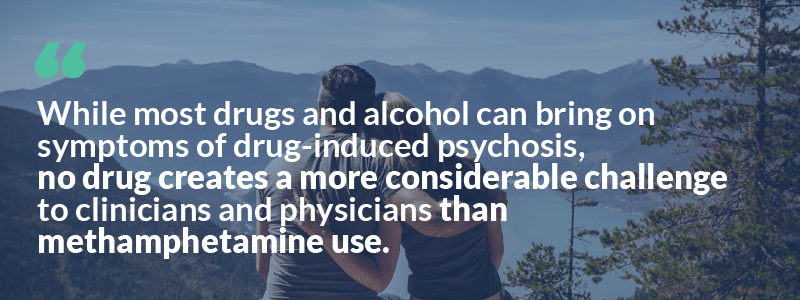Search by category, archive or keyword

It is prevalent for families of substance-using loved ones to call us in a crisis. Most of these occurrences are when their loved one is either suffering from a significant downward spiral larger than they are accustomed to or when their loved one is in a drug or alcohol-induced psychosis. Families often classify the culprit as a mental health crisis rather than a drug-induced psychosis.
Is Someone You Love Suffering from Symptoms of Drug-Induced Psychosis?
Through further conversations and exploration, families often disclose it is easier to digest and process a mental health problem than a substance use problem.
Most drugs and alcohol can alter the mind and potentially create some form of drug-induced psychosis. Stimulant drugs such as cocaine, crack cocaine, and crystal methamphetamines cause drug-induced psychosis most frequently and with more severe symptoms. Many symptoms are textbook for a mental disorder, such as anxiety, schizophrenia, bipolar I & II, and manic episodes.
In this blog, we will look at an overview of the following:
- What is drug-induced psychosis?
- Symptoms of drug-induced psychosis
- What drugs cause psychosis?
- Does drug-induced psychosis go away?
- How long does psychosis last?
- Recovery and treatment for drug-induced psychosis
The Diagnostic Statistical Manual, 5th Edition, lists drug-induced psychosis as SIPD – Substance or Medication-Induced Psychotic Disorder. The symptoms are delusions and hallucinations due to drug, alcohol, or medication use.
SIPD is very similar to the symptoms of schizophrenia, and the most significant difference is that SIPD symptoms are shorter in duration than those with a diagnosis of schizophrenia.
Drug and alcohol use does not cause schizophrenia, and if the behavior and symptoms occur due to the drug use, the symptoms will eventually subside. A person with schizophrenia who uses drugs would have had the signs before and after the drug and alcohol use stops.

Families, substance users, and clinicians are encouraged not to jump to conclusions regarding mental disorders when a mild, moderate or severe substance use disorder is present. Unfortunately, many physicians and clinicians default to mental disorders and immediately suggest or prescribe medications.
Many textbooks used in courses for clinicians at the Master’s and Ph.D. level suggest considering substance use as a result of the behaviors or symptoms until proven otherwise.
Unfortunately, the more diagnoses made, the more services can be applied and billed for. We hope this is not the motivation and unfortunately, misdiagnosis and overdiagnosis are common themes among clinicians, psychiatrists, and physicians.
A final note regarding drug-induced psychosis is when treatment is sought through a primary care physician. Going to the doctor is always a good thing if you need help. The problem starts when the primary care physician takes it upon themselves to diagnose and treat the drug-induced psychosis with medications reserved for accurately diagnosed mental disorders.
Primary care physicians are responsible for almost 80% of all mental disorder medications. Many physicians do not have the training or an integrated staff to help support the decision or the diagnosis.
When mental disorders or drug-induced psychosis is suspected, the person affected and or their family should seek help through the proper channels, such as a dual diagnosis treatment center, professional interventionist, and other addiction and mental health professionals to have an appropriate assessment and evaluation.
What is Drug-Induced Psychosis?
Drug-induced psychosis is psychosis brought on due to drug or alcohol use.
What is Psychosis?
Psychosis is when your perception is distorted to the point you rationalize insanity, and you can no longer decipher what is real from what is not.
Delusions and hallucinations are the two most common symptoms of drug-induced psychosis listed in the Diagnostic and Statistical Manual 5th Edition.
Delusions
If fifty people see the wall color as white and one is insistent that it’s blue, chances are the one who sees it as blue is delusional, barring any legitimate vision issues. The point is not to make light of a delusion as minor as mistaking the color of a wall but to help you understand what it means in more extreme cases.
Drug and alcohol users experiencing psychosis believe their distorted reality so profoundly that it appears impossible for anyone to tell them anything different.
Families often try to convince us their loved one is just stubborn. Stubbornness is not a mental disorder; psychosis is. To be stubborn, you must be rational and have a valid argument or point on which you stand firm.
Hallucinations
Hallucinations have a similar meaning to delusions and can affect all human senses. Regarding substance users, hallucinations are when the drug or alcohol user sees or believes things that are either simply not there or not true.
A delusional person or someone hallucinating can be adamant that they are correct and that everyone else is delusional or hallucinating if they don’t see it as the alcohol or drug user sees it.

It is important to let professionals determine what a mental disorder is and what symptoms stem from drug-induced psychosis and substance use disorder. Neither the family nor the patient should make these determinations alone, although history from both parties can help fill in some of the blanks. Until it can be determined, the mental health symptoms of drug and alcohol abuse should be treated with caution, and no rush to judgment should be made.
One of the best indicators is when the symptoms start, become worse, and when symptoms improve. Some substance users medicate underlying mental disorders, and others show symptoms of mental disorders due to substance use.
Please keep in mind substance users are often medicating past traumatic experiences or thoughts. They may have utilized maladaptive coping skills to divert attention from unwanted thoughts or feelings before self-medicating with drugs and alcohol.
These coping mechanisms have been known to mimic mental disorder symptoms too. The point is that professional help is necessary, and no family or patient should take on the role of patient and clinician alone.
Symptoms of Drug-Induced Psychosis
Drug and alcohol use often changes many aspects of a person’s life. Aside from the physical downfall due to drug and alcohol use, changes in a user’s behavior and perception are initially the most noticeable.
While most drugs and alcohol can bring on symptoms of drug-induced psychosis, no drug significantly challenges clinicians and physicians more than methamphetamine use. In our experience, there has never been one family inquiring about the services that did not try to convince themselves or us that their loved one using crystal meth had mental disorder concerns.
Almost every time we were allowed to work with the family and their loved one, with the substance user entering treatment, the symptoms of the drug-induced psychosis almost always subsided within six months. These results may have differed if the client entered a treatment center that was not equipped with a well-versed integrated treatment team that immediately diagnosed mental disorders before addressing methamphetamine use.

As previously stated, clinicians and physicians should rule out and address substance use before making an accurate mental disorder diagnosis. When substance use is present, it can and most likely will create symptoms of mental disorders whether or not an actual mental illness is present. Substance use can develop and worsen mental health disorders not yet present in the client.
We have already discussed delusions and hallucinations above, which are the most common symptoms of drug-induced psychosis. Next, we will list some of the clients’ most common drug-induced psychosis symptoms during the intervention and assessment process.
Some of these may not be listed in their clinical terms but rather the actual behaviors we see as a result of the drug or alcohol-induced psychosis:
- Paranoia
- Mania
- Mood Changes
Symptom One: Paranoia
Paranoia is a prevalent symptom of drug use, especially methamphetamine, cocaine, crack, and marijuana. Many substance users abusing these drugs have hallucinations, delusions, and distorted perceptions around this paranoia.
Some of the most frequent symptoms reported are:
- Law enforcement is watching them or closing in on them.
- They have bugs crawling on their skin.
- Somebody or something has planted a recording device in them or their walls.
- There are now cameras hidden somewhere, and they have to find them.
- Satellite cameras track them, or someone has put a tracking device on their phone.
- Lack of trust, and everyone is out to get them or against them.
- Hearing voices
Many of these symptoms stem from the drugs listed above, which can occur with other substances. The paranoia experienced by the drug user can be overwhelming for them and those around them.
The stress and the mania that comes with these beliefs can become a full-time job of worry for the paranoid drug user and those closest to the substance user. Stimulant users have reported instant paranoia every time the drug is consumed.
For instance, the first hit from a crack or meth pipe can cause the user to run and hide under a bed or in a closet after shutting the blinds and locking their doors.
This drug-induced psychosis can scare the substance user and their family, yet it isn’t a strong enough deterrent from future drug use. The gratification the substance use brings to the user is overridden by the paranoia that follows it.
Symptom Two: Mania
It may not be a coincidence that the majority of families believe their loved one is bipolar based on the behaviors they see. Additionally, it is not a coincidence that many substance users are diagnosed with bipolar disorder by their family doctor or psychiatrist. This diagnosis could be coming from either the substance user not being honest about their drug or alcohol use or the doctor or clinician treating the symptoms, not the actual cause.
Mania often occurs with stimulant users, and it also occurs frequently with opioid users. Many people assume opioids cause sleepiness and drowsiness. When someone is abusing opioids, the opposite effect often occurs. It is not uncommon for an opioid user to experience a burst of energy from consuming the drug.

Opioid users have been known to talk non-stop or clean the entire house just like a stimulant user would. Many family members of opioid users believe their loved one abusing opiates has a mental disorder because they were unaware that opioids often create a stimulant effect in the experienced user.
Here are some of the drug-induced psychosis behavior that parallels those of a Manic Disorder:
- High Energy
- Easily or more frequent, anger and agitation
- Grandiose Behavior
- Insomnia
- Non-Stop Talking
- Racing thoughts
- Easily Distracted, jumping from one task to another
From these drug-induced psychosis symptoms, you can see how easy it would be for a clinician, doctor, or psychiatrist to mistake them for a mental disorder. Drug-induced mania parallels some bipolar symptoms, manic disorder, and mood disorders, to name a few.
As stated numerous times and in many books of study, the clinician, doctor, psychiatrist, and treatment team should assume the symptoms result from drug or alcohol use until it can be proven otherwise.
Symptom Three: Mood Changes
Drugs and alcohol use can change one’s perception even with low consumption levels. Mood changes often follow when alcohol or drugs are used regularly or in high amounts. People contact a professional because of behaviors, whether they realize that or not.
If drug or alcohol users can consume substances with no change in behavior or negative effect on themselves or others, we probably would not have many people inquiring about getting help.
When substance users start affecting themselves and others, people often decide to explore their options. Although there are too many to list, here are some of the most common mood changes we see due to drug and alcohol use.
Read More: When Loss of Self-Control Is Really an Impulse Control Disorder
Many of them are the same as those seen in an Antisocial Personality Disorder diagnosis:
- Lack of empathy and consideration for others
- Disregard for authority or rules
- Anger
- Manipulations
- Isolation
- Lack of motivation
- Anger
- Fear
- Resentments
- Victim
- Blaming others
- Argumentative
- Aggressiveness
- Impulsive
- Lack of responsibility and accountability
- Rage
- Depression
Drug addiction and alcoholism create a distorted perception and change in behavior and mood. Drug and alcohol addiction treatment doesn’t simply teach someone how to avoid drinking alcohol or drug use; it seeks to address the behaviors that lead to drug and alcohol use. The deeper dive is exploring where the behaviors are coming from.
Are the behaviors a genuine mental disorder, or are they unresolved traumatic experiences in which the person is acting out?

Think about antisocial personality disorder; The most significant difference between it being caused by drugs or alcohol is its onset of symptoms. Most clients with antisocial personality disorder are diagnosed with a conduct disorder before age 15.
Is it a conduct disorder, or is the child acting out?
If the child witnesses their dad abusing their mom and then goes to school and bullies other students as a result, is this a conduct disorder or unresolved trauma?
When the family informs us their loved one was this way long before they used drugs or alcohol, is this from medicating a mental disorder, or are these behaviors from medicating trauma?
The question then becomes: Is the solution more legally prescribed drugs to not think about the experiences, or is the solution to address the experiences?
The DSM lists every possible disorder based on almost every behavior you can think of. Are these actual disorders, or are they unresolved traumas that can be resolved in therapy or treatment instead of a doctor’s office or pharmacy?
What Drugs Cause Psychosis?
If you base this question on the most prevalent symptom of drug-induced psychosis – delusional thoughts – then the answer would be almost all. If you look above at the signs of paranoia and mania, the answer would be opioids, stimulants, and amphetamines.
When you look at the mood changes section, this could include others such as alcohol, benzodiazepines, marijuana-induced psychosis, hallucinogens, and designer drugs.
Drugs and alcohol alter perception and change your thinking. If the definition of psychosis is impaired thoughts and emotions, then any mind-altering substance can cause psychosis.

The question of what drugs cause psychosis is not the issue at hand.
The question is: What trauma or past experiences are so hurtful that a substance user would consume the drugs or alcohol knowing the results of the consumption will most often end in a destructive way to both mind and body?
The substance user is trying to fill a void or a hole.
What is the void, how deep is the hole, and what created it?
Is it a mental disorder, or is it some form of trauma through horrification or emotional damage, whether minimal or extensive in scope?
Ultimately, the drug of choice is not nearly as important as why they must start using drugs or alcohol.
Indeed, all drugs and alcohol have their challenges and risks. Rather than wondering why they use a particular drug, the deep dive is finding out what they are running from and what pain they seek to avoid by using any drug.
Does Drug-Induced Psychosis Go Away?
Drug-induced psychosis does go away, and the answer is not as simple as yes when the person stops using drugs. The symptoms of drug-induced psychosis are clearly from the drug use, hence the name.
The question is: When was the onset of symptoms?
If the behavior was present before the drug use, then why?
If the answer is that all of the symptoms started after the drug use, they will most likely end sometime after stopping the drug use. When people use drugs or alcohol, they often attempt to self-medicate emotions, feelings, and beliefs stemming from current or past experiences.
The substance user could also be trying to self-medicate a genuine mental disorder. Drug and alcohol use can worsen mental disorder symptoms. It can allow identical symptoms of a mental illness to appear as the result of drug or alcohol use when no previous mental disorder existed.
The answer as to when the psychosis goes away varies. Regardless of the cause, stopping drug use will reduce drug-induced psychosis symptoms. Even when an actual mental disorder is present, ceasing drug and alcohol use will significantly reduce the symptoms made worse by substances.
What about the drug or alcohol user who doesn’t have a mental disorder yet still has questionable behavior after the substance stops? This is why it is difficult to answer the question. The reason is that recovery from substances is not simply abstinence; it is about behavior modification and change of perception.
If the substance user is acting out childhood trauma with substance use and the substance use stops, they will most likely revert to the behaviors that led to the substance use and still present symptoms. The symptoms are not likely to go away until the trauma is addressed and perception has changed; abstinence is not enough.
When someone is using a substance that is affecting their mood and mental health, the first thing that has to happen is the person should detox from all drug and alcohol use under medical supervision.
After they are medically stabilized and cleared, the professional integrated treatment team can closely monitor the client and document symptom severity. As previously stated, in almost every case, symptoms will decrease, and conditions will improve, although the symptoms may not disappear immediately.
Ongoing evaluations and assessments are vital to an ongoing treatment plan. In the proper setting, clients can work with their treatment team through rigorous honesty to explore the root cause of the problem.
How Long Does Psychosis Last?
As stated above, drug-induced psychosis lasts as long as it lasts based on the cause of the psychosis. Stopping drug and alcohol use is the only way for professionals to arrive at the actual root cause of the behaviors. So, in theory, the psychosis caused exclusively by the drug or alcohol use lasts until the drug and alcohol use stops, with some carrying over into the abstinence period.
Most people present symptoms and volatility in their behavior for weeks and months after stopping using substances. Many people report a major reduction in symptoms after stopping, which gets better each day.

One of the most significant determining factors for clinicians was when the symptoms started and stopped. Mental disorders certainly improve when substance use stops, but their mental disorder remains.
For example, a substance user ingesting crystal methamphetamines and hearing voices will most likely stop hearing voices after they stop using. A client with an accurate schizophrenia diagnosis will not stop hearing voices after they stop using crystal methamphetamines or other drugs and alcohol.
Another example is Antisocial Personality Disorder. The symptoms may improve due to stopping drug and alcohol use and may not go away completely. Does this mean they have an accurate ASPD diagnosis, or do they have unresolved trauma and require therapy? In this example, the symptoms can last as long as the client is willing to be honest with their treatment team about their life experience and history.
Not all diagnosed mental disorders are accurately diagnosed mental disorders. It is not uncommon to misdiagnose mental disorders, especially when the client has a history of trauma and drug or alcohol use.
As previously stated, most mental disorder medications are prescribed by family doctors with little to no training in mental health. Some symptoms can result from someone acting out behaviorally due to unresolved issues. A clinician can only diagnose as accurately as the client is honest.
Recovery and Treatment for Drug-Induced Psychosis
Nobody has the complete answer when looking at the dismal percentages of positive outcomes for substance use and mental health.
Almost every aspect of mental health and substance use treatment is a hypothesis or educated guess. Some things have standard effective solutions, and for many other pieces of the puzzle, there are far too many variables to say there is a one-size-fits-all approach.
The one approach that does seem to be overwhelmingly utilized and possibly contributing to the dismal success rates is the misdiagnosis of symptoms and conditions.
Today’s treatments appear to look at all cases through the eyes of medication management as the immediate solution. Although this can work for some, it may not work for everyone.
It would be a stretch to say that every substance user has a mental disorder that requires medication. It is an even further stretch to say that every symptom of a diagnosed mental disorder is nothing more than a mental disorder when we know it could result from acting out unresolved traumas that check many boxes on the symptoms list.
The point is that when a substance use disorder is present, the integrated treatment team cannot make an accurate mental health diagnosis until the substance use has stopped and some time has passed. The information doesn’t tell all, even with a previous medical history and treatment attempts.
Let’s face it – if the past attempts at treating the problem were successful, the client would not be looking for more help. The question should always be, are the symptoms a result of substance use, psychosis from the substances, a mental disorder, unresolved trauma, or some or all combined?
Professional Interventionists Can Help Your Family
Earlier, we stated how almost every family of substance users believe the problem’s root cause is a mental disorder, especially in stimulant and amphetamine use cases.
Sometimes, the families state their loved one was perfect until they started using substances. Others suggest their loved one experienced difficulties and struggles long before the substance use.
When a family chooses a professional interventionist, they allow themselves to share the background story absent of the substance user.

Providing truthful and accurate information can help the professional interventionist’s overall assessment and proper treatment recommendations. The interventionist may not be the substance user’s therapist, and they can be vital to the comprehensive treatment plan for both family and drug or alcohol users.
Families trying to navigate the cause of the problem is not always the best course of action. As you have read throughout this article, there is no way to truly know where the symptoms come from until the substance use has stopped.
Until both the family and substance user are separated and stabilized in their recovery efforts, little to nothing can be solved or accomplished. The more honest the family is with the interventionist and the substance user with their treatment team, the greater the opportunity for success.
The professional interventionist, clinician, doctor, psychiatrist, etc., is only as effective as the accuracy and honesty of the information provided. Not telling the whole story can compromise the chances of success for all those involved.
Family First Intervention looks forward to hearing your story and seeing how we can help. Feel free to call us anytime so we can listen and try to provide any requested feedback in the form of an effective solution.
An intervention is not about how to control the substance user; it is about how to let go of believing you can.
“The most formidable challenge we professionals face is families not accepting our suggested solutions. Rather, they only hear us challenging theirs. Interventions are as much about families letting go of old ideas as they are about being open to new ones. Before a family can do something about the problem, they must stop allowing the problem to persist. These same thoughts and principles apply to your loved one in need of help.”
Mike Loverde, MHS, CIP



